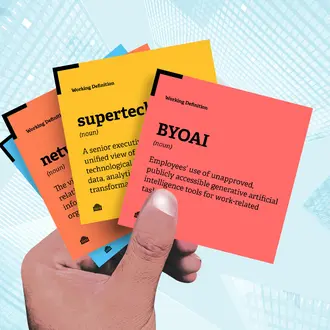Credit: Stephen Sauer
George Chu was raised to be a reader. His father kept a home library stocked with a range of genres, and when a particular topic interested him, he might buy a half-dozen books on the subject for his deep dive.
“Growing up with this breadth and depth of ideas in different formats and contexts taught me to see patterns in both problems and answers,” said Chu, senior vice president of finance and business analytics at City Year.
The education nonprofit places young adult volunteers in schools around the country to help students stay enrolled, engaged, and to eventually graduate. He is also the founder and a principal at consulting firm The Room40 Group, where clients are also nonprofits.
We spoke with the 2004 MBA alumnus about finding inspiration in the British admiralty, his “back pocket prototypes” for testing ideas, and second-guessing disagreements.
Who inspires you?
I don’t have big names to drop but we all have them in our lives: mom, church friend, high school buddy. People who tirelessly, relentlessly and consistently do the right thing. They always stop to help friends and strangers, put others first, seek to do right. This requires such mindfulness that I am inspired and jealous. These people change the world in small ways.
I also know from my youth/education work that this mindset is critical. Surround a young person with people like this and opportunities will abound. We can’t predict when or how, but we do know flooding the zone will greatly improve the odds of a healthy, happy future.
Where do you get ideas?
My primary source of ideas is other people via history, other businesses, other executives. I excel at adapting existing ideas and solutions to new contexts, situations, and problems. If you’re looking for the next paradigm-busting, completely out of the box idea, I’m probably not your guy. But if you want to be better, faster, cheaper within the box, let’s talk.
My current favorite place to mine ideas is World War II, and in particular the birth of operations research. The combination of new techniques, high stakes, and focused talent and investment allowed people to move quickly from data to action, often with simple but powerful insights. War is a terrible crucible.
How are new ideas discovered and developed in your organization?
I will speak to Room40 as this was a structured and deliberate process. Our tagline was “better decisions, faster.” We were all former consultants and executives. We could often quickly “recognize” a client’s problem and identify the three to five viable solutions, pros and cons in a very short period of time. We would help the client “try on” each solution, decide, and implement. Often this meant we got them to a 20% better answer in half the time.
In fact, the name Room40 represents this concept. In WWI, the British admiralty stumbled across a German naval codebook. Breaking the code would yield tremendously actionable intelligence. Codebreaking as a discipline did not yet exist so they convened a motley crew of banking executives, German linguists, biblical scholars; anyone they thought could contribute. They cracked the code and gave birth to a new discipline in the process. The place they met was Room 40 of the admiralty building.
We founded our company because we felt the nonprofit sector faces similar challenges. Our client base has a similar motley set of knowledge, skills, and expertise. We wanted to be the figurative “room” where they could convene to crack and share the code.
How do you keep track of new ideas?
Reading and observing generates a lot of ideas for me. Unfortunately, they go as quickly as they come so if I do not document, they get lost. In addition, I cannot assess the quality of the idea in real time, so I cannot triage up front.
I’ve evolved to a solution where I have a simple “idea” Google form on my phone. When inspiration hits, I jot it in the form, which dumps it into a spreadsheet in the cloud.
Periodically I’ll print it out on separate bits of paper and stick them in a jar. Now and again I pull a bunch out and read. It’s pretty hilarious because they fall in three categories:
- Hey good idea, will follow up.
- Wow, stupid. What was I thinking?
- I have no idea what this means.
Seems to both work and entertain.
How do you test ideas?
I’m fairly informal. I will build a use case or simple prototype and keep it in my back pocket while seeking an opportunity to showcase. If the opportunity never presents or I cannot engineer, it is probably a solution in search of a problem.
When I do get the opportunity I’ll pull it out as “Hey, here’s a thought.” If it gets traction, I’ll move quickly from back pocket prototype to product or deliverable. If it doesn’t, I’ll assess why. About one-third of the time it just isn’t a good solution. Another one-third is good solution but wrong pitch or frame. Last one-third may be good solution, right pitch, but the audience isn’t getting it, so I have more convincing to do. Sometimes that is repetition, sometimes more context, sometimes a change in messenger.
When do you know it is time to abandon an idea?
I’m not sure I ever do, for better or worse. Ideas are like books for me. I may not read every day. I may read once in a while or just look and remember fondly. But I know there is utility in that book and while I may not need it now, it’s there for me. So presuming sufficient shelf space, I’ll keep it on that shelf until I have a need or see a way to adapt and combine to make something new.
What was your worst idea?
Sadly, I seem to think they are all good and it is a matter of waiting to find the right application.
How do you know an idea is a good one?
When it’s useful.
At MIT Sloan, we talk about ideas made to matter — ideas that are carefully developed and have meaningful impact in the world. In that context — what is your idea made to matter?
There are three themes:
- Data, stories, and wisdom. I’m a data guy, and love the application of analytics to decision-making. However, I also love a good story. I’m not the first to realize the combination of the two is a powerful way to pass along wisdom.
- Small, meaningful, high-volume, and repeatable decisions add up to massive and sustainable change.
- When it comes to decision-making, 80% of the time we disagree, we actually don’t. Equalize the fact base, created shared language, and 80% of the time we’ll find we agree — or close enough. The 20% left over is healthy. We should fight over some stuff, but imagine the productivity gain if we can focus on the 20% and not the 80%.



